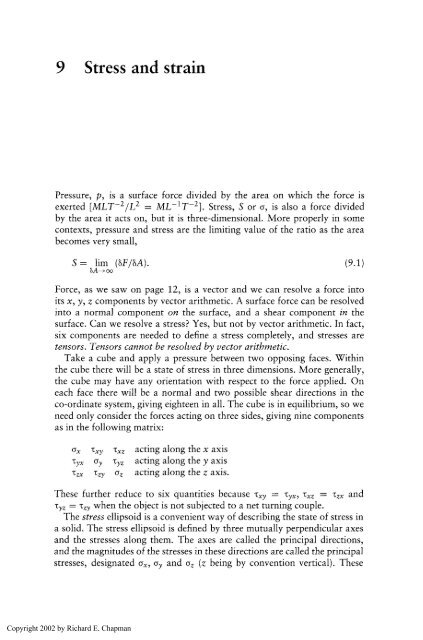Physics for Geologists, Second edition
Physics for Geologists, Second edition
Physics for Geologists, Second edition
Create successful ePaper yourself
Turn your PDF publications into a flip-book with our unique Google optimized e-Paper software.
9 Stress and strain<br />
Pressure, p, is a surface <strong>for</strong>ce divided by the area on which the <strong>for</strong>ce is<br />
exerted [MLT-~/L~ = ML-~T-~]. Stress, S or a, is also a <strong>for</strong>ce divided<br />
by the area it acts on, but it is three-dimensional. More properly in some<br />
contexts, pressure and stress are the limiting value of the ratio as the area<br />
becomes very small,<br />
S = lim (@/&A).<br />
GA-too<br />
Force, as we saw on page 12, is a vector and we can resolve a <strong>for</strong>ce into<br />
its x, y, z components by vector arithmetic. A surface <strong>for</strong>ce can be resolved<br />
into a normal component on the surface, and a shear component in the<br />
surface. Can we resolve a stress? Yes, but not by vector arithmetic. In fact,<br />
six components are needed to define a stress completely, and stresses are<br />
tensors. Tensors cannot be resolved by vector arithmetic.<br />
Take a cube and apply a pressure between two opposing faces. Within<br />
the cube there will be a state of stress in three dimensions. More generally,<br />
the cube may have any orientation with respect to the <strong>for</strong>ce applied. On<br />
each face there will be a normal and two possible shear directions in the<br />
co-ordinate system, giving eighteen in all. The cube is in equilibrium, so we<br />
need only consider the <strong>for</strong>ces acting on three sides, giving nine components<br />
as in the following matrix:<br />
a, tXy t,, acting along the x axis<br />
ty, ay tyZ acting along the y axis<br />
t,, tZy aZ acting along the z axis.<br />
These further reduce to six quantities because tXy = ty,, txz = t,, and<br />
ty, = tZy when the object is not subjected to a net turning couple.<br />
The stress ellipsoid is a convenient way of describing the state of stress in<br />
a solid. The stress ellipsoid is defined by three mutually perpendicular axes<br />
and the stresses along them. The axes are called the principal directions,<br />
and the magnitudes of the stresses in these directions are called the principal<br />
stresses, designated a,, a, and a, (z being by convention vertical). These<br />
Copyright 2002 by Richard E. Chapman






